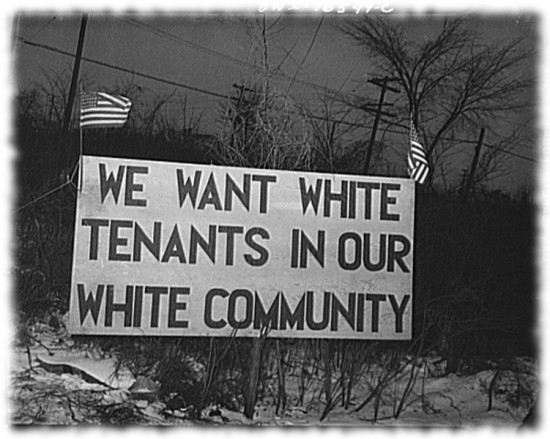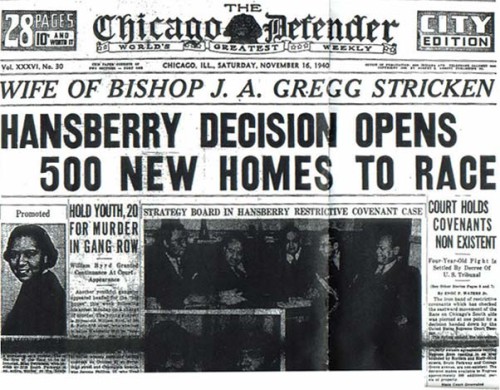by Natalie Y. Moore
Lorraine Hansberry v. Anna Lee
The Hansberry saga is just one story in the fight against segregation in Chicago. Most people know that Lorraine Hansberry, author of the play “Raisin in the Sun” was from Chicago. But most people — I’m including Chicagoans, too — don’t know that the play drew inspiration from her own family’s story.
To recap, in the play the Younger family wanted to use insurance money to leave their tenement in a black neighborhood and move into a white neighborhood. A white homeowners improvement association tried to prevent the Youngers from moving.

In reality, the Hansberry story was more overtly racist and violent. In 1937, prominent businessman Carl Hansberry bought a home in the white South Side Woodlawn neighborhood just south of the University of Chicago. White mobs greeted the family and a brick almost hit eight-year-old Lorraine Hansberry. At night her mother, Nannie, patrolled the house with a gun.
The mobs didn’t run out the Hansberrys. The courts did. Anna Lee, a white neighbor, sued arguing a restrictive agreement prevented the sale of blacks to the neighborhood. Illinois courts agreed and the Hansberrys were forced to leave. Racially restrictive covenants consistently kept blacks in residential segregation. Those convents prevented African Americans in Chicago and elsewhere around the United States from buying or renting homes in white neighborhoods. On the South Side of Chicago, the overcrowded Black Belt housed too many families in too many shoddy conditions. White home improvement associations served as gatekeepers to prevent blacks from moving into their neighborhoods.
But Carl Hansberry challenged white property owners. Hansberry v Lee went to all the way to the U.S. Supreme Court in 1940. He won. But on a technicality. Although the court ruled in his favor, invalidating the restrictive covenant, the reasoning wasn’t based on the constitutionality. The court said Lee and more than 500 landowners signed the restrictive agreement. But that wasn’t enough. The agreement was was deemed ineffective unless 95 percent signed; only 54 percent signed. The court win allowed 500 homes to open up to blacks in Woodlawn.
Hansberry v Lee set the stage for the 1948 case that did finally strike down racially restrictive covenants: Shelley v. Kraemer, a case out of St. Louis.

The Lorraine Hansberry saga is just one story in the fight against segregation in Chicago. The Great Migration began in Chicago a century ago and celebrations will take place throughout the year in the city. From 1916-1970, 500,000 black Southerners made their way to Chicago searching for jobs, escaping sharecropping and racial violence or following family.
As soon as blacks stepped off trains, a racist real estate system and government conspired to contain them in the Black Belt. The Chicago Real Estate Board recommended that black areas keep being filled to prevent blacks from moving to white areas. Restrictive covenants were added to property deeds. Redlining prevented lending to blacks. After the U.S. Supreme Court struck down the restrictive covenants, blacks could move elsewhere in the city. Whites either exacted violence on new families or fled. From 1950 until 1960, a number of South Side neighborhoods transitioned from 99 percent white to 99 percent black. White flight easily happened because suburbs were built and highways to those suburbs were constructed.
The Chicago region, like other cities in the Midwest and Northeast, continue to deal with the fallout of Jim Crow of the North.
NATALIE Y. MOORE is the South Side bureau reporter for WBEZ, the NPR-member station in Chicago, where she’s known as the South Side Lois Lane. Before joining WBEZ, she covered Detroit City Council for Detroit News. She worked as an education reporter for the St. Paul Pioneer Press and a reporter for the Associated Press in Jerusalem. Her work has been published in Essence, Black Enterprise, the Chicago Reporter, In These Times, the Chicago Sun-Times and the Chicago Tribune. She lives in Chicago and is the author of THE SOUTH SIDE: A Portrait of Chicago and American Segregation.
